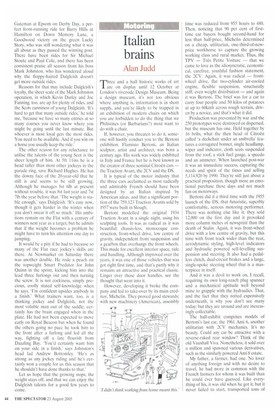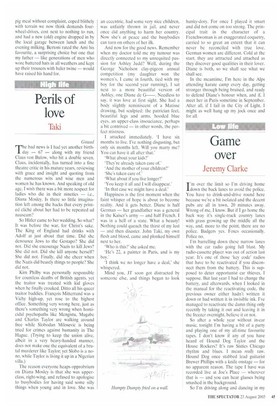Italian brains
Alan Judd
Three and a half historic works of art are on display until 12 October at London's riverside Design Museum. Being a design museum, it's not too obvious where anything is, information is in short supply, and you're likely to be trapped in an exhibition of modern chairs on which you are forbidden to do the thing that we Philistines (or Barbarians?) most want to do with a chair.
If, however, you threaten to do it, someone will hastily conduct you to the Bertoni exhibition. Flamini° Bertoni, an Italian sculptor, artist and architect, was born a century ago. His work was widely exhibited in Italy and France but he is best known as the creator of three seminal Citroen cars — the Traction Avant, the 2CV and the DS.
It is typical of the motor industry that the three cars acclaimed as most radically and admirably French should have been designed by an Italian inspired by American ideas, and that a significant portion of the 759,123 Traction Avants sold by 1957 were built in Slough.
Bertoni modelled the original 1934 Traction Avant in a single night, using his sculpting tools. It was as radical as it was beautiful: chassis-less. monocoque construction, front-wheel drive, low centre of gravity, independent front suspension and a gearbox that overhangs the front wheels. This made for excellent interior space, ride and handling. Although improved over the years, it was one of those vehicles that was got right first time, and that's partly why it remains an attractive and practical classic. Linger over those door handles, see the thought that went into it.
However, developing it broke the company and led to take-over by its main creditor, Michelin. They proved good stewards; with new machinery (American), assembly time was reduced from 955 hours to 480. Then, noticing that 90 per cent of firsttime car buyers bought second-hand for less than half-price, Michelin determined on a cheap, utilitarian, one-third-of-newprice workhorse to capture the growing working class and rural market. Thus, the TPV — Tres Petite Voiture — that we came to love as the idiosyncratic, economical, carefree, youthful fashion statement, the 2CV. Again, it was radical — frontwheel drive, flat two-cylinder air-cooled engine, flexible suspension, structurally stiff, even weight distribution — and again it was Bertoni. The brief was for a car to carry four people and 50 kilos of potatoes at up to 60kmh across rough terrain, driven by a novice, and that's what it did.
Production was prevented by war and the 250 prototypes were destroyed or dispersed, but the museum has one. Held together by 16 bolts, what the then head of Citroen called 'a deckchair under an umbrella' features a corrugated bonnet, single headlamp, wiper and indicator, cloth seats suspended from the roof, a stick fuel gauge, a speedo and an ammeter. When launched post-war it was an immediate success, capturing the needs and spirit of the times and selling 5,114,920 by 1990. They're still just about a practical proposition, though more an emotional purchase these days and not much fun on motorways.
Bertoni did it a third time with the 1955 launch of the DS, that futuristic, superbly comfortable, serious motoring performer. There was nothing else like it; they sold 12,000 on the first day and it provoked more column inches of newsprint than the death of Stalin. Again, it was front-wheel drive with a low centre of gravity, but this time with front track wider than the rear, aerodynamic styling, high-level indicators and hydraulic powered self-levelling suspension and steering. It also had a pedalless clutch, dual-circuit brakes and a large, single-spoke steering wheel that is a masterpiece in itself.
And it was a devil to work on, I recall, requiring its own long-reach plug spanner and a mechanical aptitude well beyond mine to grapple with the hydraulics. That, and the fact that they rotted expensively underneath, is why you don't see many today; but they are around and are increasingly collectable.
The half-exhibit comprises models of Bertoni's last car, the 1961 Ami 6, another utilitarian with 2CV mechanics. It's no beauty. Could any car be attractive with a reverse-raked rear window? Think of the old Vauxhall Viva. Nonetheless, it sold over a million and spawned various derivatives, such as the similarly powered Ami 8 estate.
My father, a farmer, had one. No lover of anything foreign and with no desire to travel, he had more in common with the French farmers for whom it was built than he could ever have guessed. Like everything of his, it was old when he got it, but it never failed to start, transported tons of pig meal without complaint, coped blithely with terrain we now think demands fourwheel-drives, cost next to nothing to run, and had a new (old) engine dropped in by the local garage between lunch and the evening milking. Bertoni rated the Ami his favourite, a surprising choice but one that my father — like generations of men who wore battered hats in all weathers and kept up their trousers with baler twine — would have raised his hand for.



























































 Previous page
Previous page